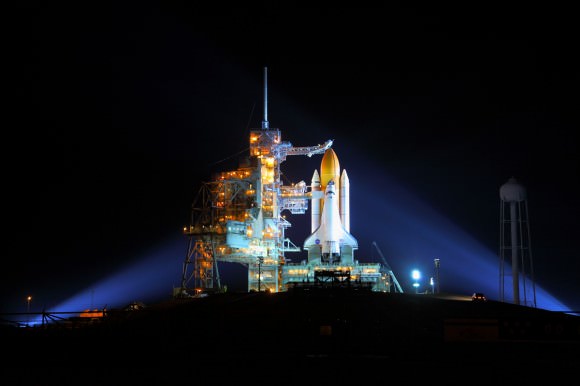[/caption]
While NASA managers have targeted space shuttle Discovery’s launch for no earlier than Dec. 17, they also said they don’t want to rush to any conclusions on the cracks found on the shuttle’s external tank. Therefore, shuttle program manager John Shannon said that if the team doesn’t completely understand the issues, they won’t launch until they do. That might mean mid-December, or it might mean they wait for the next launch window, which is in February of 2011 — or even later.
“It’s a complex problem,” said Shannon. “We really need to understand our risk. Clearly we’re not ready for the December 3 -7 window that’s coming up.”
“We are methodically looking at the data and we’ll let data the drive where we’re heading, drive when we launch,” said Bill Gerstenmaier, NASA’s Associate Administrator for Space Operations, speaking at a press briefing on Wednesday.
Engineering evaluations are ongoing of the four cracks on found on two 21-foot-long, U-shaped aluminum brackets called stringers on the shuttle’s external tank, and Shannon said they still need more analysis until they understand everything. The only previous time cracks like this have been seen are during the assembly process, or if the tank has been mishandled during assembly – cracks like this have never been seen at the launchpad before.
“We have worked hard to understand the exposure, and we want to understand everything,” Shannon said. “We’re looking at the fault tree from assembly, to how it gets foamed, to transport, to how it gets to KSC – every single part of that tank’s life is part of our fault tree analysis.”
It appears the biggest worry is not that the tank would fall apart during the stresses of launch, but that foam would be dislodged from the tank, which could impact the shuttle during launch. Foam from the ET is what damaged space shuttle Columbia, and caused it to disintegrate during reentry in 2003, killing all seven astronauts on board.
If the teams feel their analysis is complete and they have the flight rationale to fly, the earliest launch date would be Friday, Dec. 17 at 8:51:53 pm EST.
A Soyuz is scheduled to dock at the space station at 3 pm EST that day, carrying three new crew members to the ISS.
No launch dates are available in January 2011 because of constraints with the orbit of the space station and conflicts with other unmanned cargo launches. The launch window in February opens on the 27th and closes March 6. Another window, Feb. 3 -10 could be available if the Japanese cargo ship, scheduled to arrive in late January, can be moved to another port on the space station.
We’ll keep you posted.


It is good that care was taken to find these cracks, and that the occurrence of the cracks is meticulously scrutinized.
The Challenger was lost because there was a problem the officers in charge prefered to ignore and gave the start a go. That go did not dissolve the problem, and so the problem dissolved the Challenger and its wonderful crew.